 |
BMC511S - BUSINESS MANAGEMENT INFORMATION - 2ND OPP - JULY 2024 |
 |
1 Page 1 |
▲back to top |
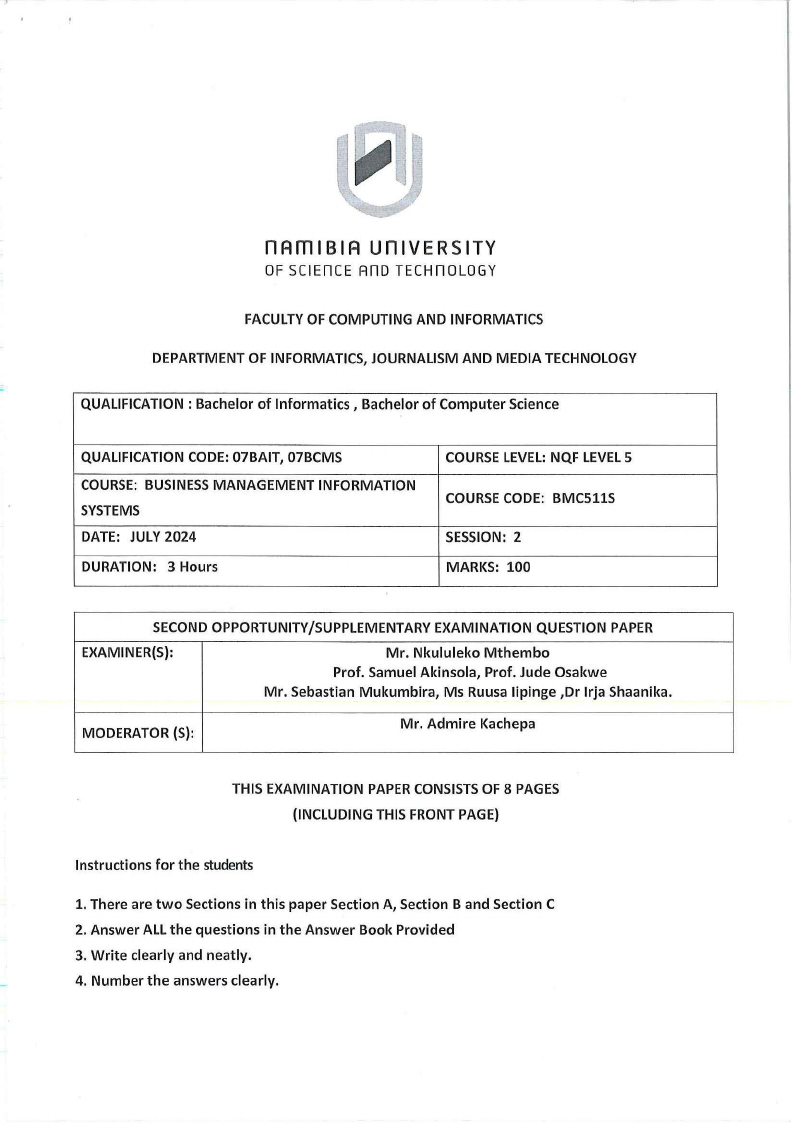
n Am I BI A u n IVER s ITY
OF SCIEnCE AnD TECHnOLOGY
FACULTY OF COMPUTING AND INFORMATICS
DEPARTMENT OF INFORMATICS, JOURNALISM AND MEDIA TECHNOLOGY
QUALIFICATION : Bachelor of Informatics, Bachelor of Computer Science
QUALIFICATION CODE: 07BAIT, 07BCMS
COURSE: BUSINESSMANAGEMENT INFORMATION
SYSTEMS
DATE: JULY2024
DURATION: 3 Hours
COURSELEVEL:NQF LEVEL5
COURSECODE: BMC511S
SESSION: 2
MARKS: 100
SECONDOPPORTUNITY/SUPPLEMENTARY EXAMINATION QUESTION PAPER
EXAMINER(S):
Mr. Nkululeko Mthembo
Prof. Samuel Akinsola, Prof. Jude Osakwe
Mr. Sebastian Mukumbira, Ms Ruusa lipinge ,Dr lrja Shaanika.
MODERATOR (S):
Mr. Admire Kachepa
THIS EXAMINATION PAPER CONSISTS OF 8 PAGES
(INCLUDING THIS FRONT PAGE)
Instructions for the students
1. There are two Sections in this paper Section A, Section B and Section C
2. Answer ALL the questions in the Answer Book Provided
3. Write clearly and neatly.
4. Number the answers clearly.
 |
2 Page 2 |
▲back to top |
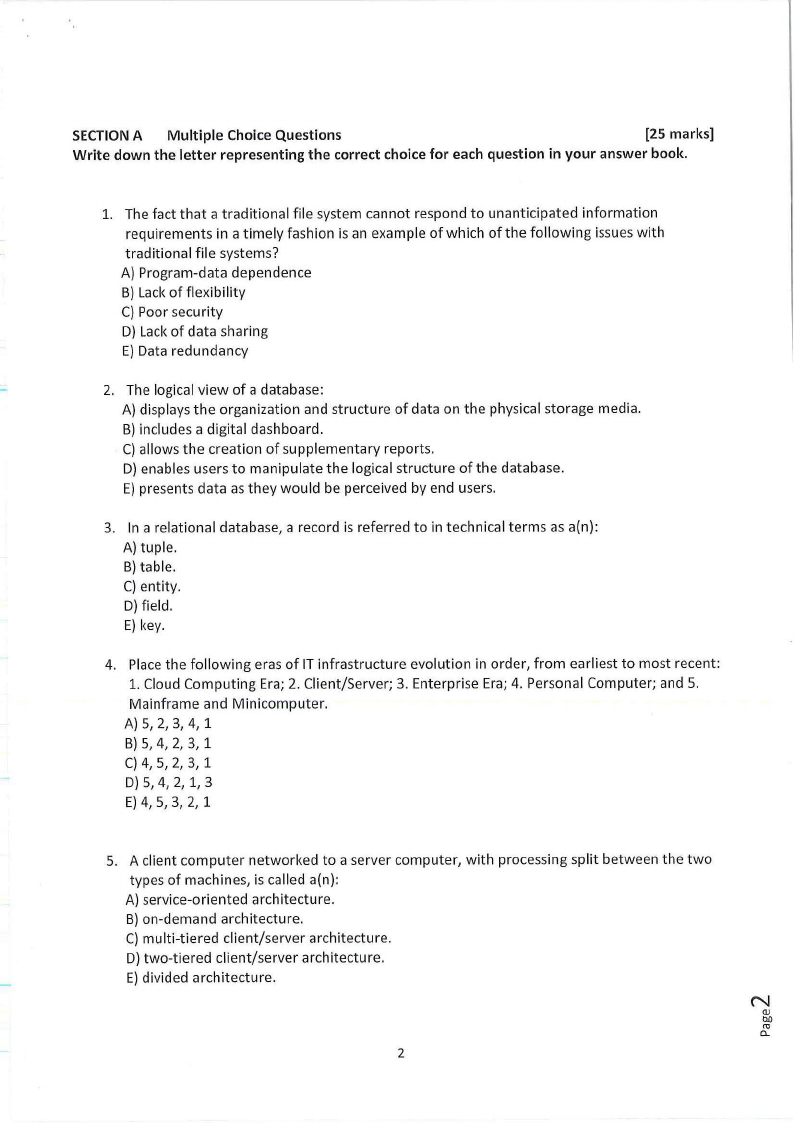
SECTIONA Multiple Choice Questions
[25 marks]
Write down the letter representing the correct choice for each question in your answer book.
1. The fact that a traditional file system cannot respond to unanticipated information
requirements in a timely fashion is an example of which of the following issues with
traditional file systems?
A) Program-data dependence
B) Lack of flexibility
C) Poor security
D) Lack of data sharing
E) Data redundancy
2. The logical view of a database:
A) displays the organization and structure of data on the physical storage media.
B) includes a digital dashboard.
C) allows the creation of supplementary reports.
D) enables users to manipulate the logical structure of the database.
E) presents data as they would be perceived by end users.
3. In a relational database, a record is referred to in technical terms as a(n):
A) tuple.
B) table.
C) entity.
D) field.
E) key.
4. Place the following eras of IT infrastructure evolution in order, from earliest to most recent:
1. Cloud Computing Era; 2. Client/Server; 3. Enterprise Era; 4. Personal Computer; and 5.
Mainframe and Minicomputer.
A) 5, 2, 3, 4, 1
B)5, 4, 2, 3, 1
C) 4, 5, 2, 3, 1
D) 5, 4, 2, 1, 3
E)4, 5, 3, 2, 1
5. A client computer networked to a server computer, with processing split between the two
types of machines, is called a(n):
A) service-oriented architecture.
B) on-demand architecture.
C) multi-tiered client/server architecture.
D) two-tiered client/server architecture.
E) divided architecture.
N
QJ
ti()
ro
CL
2
 |
3 Page 3 |
▲back to top |
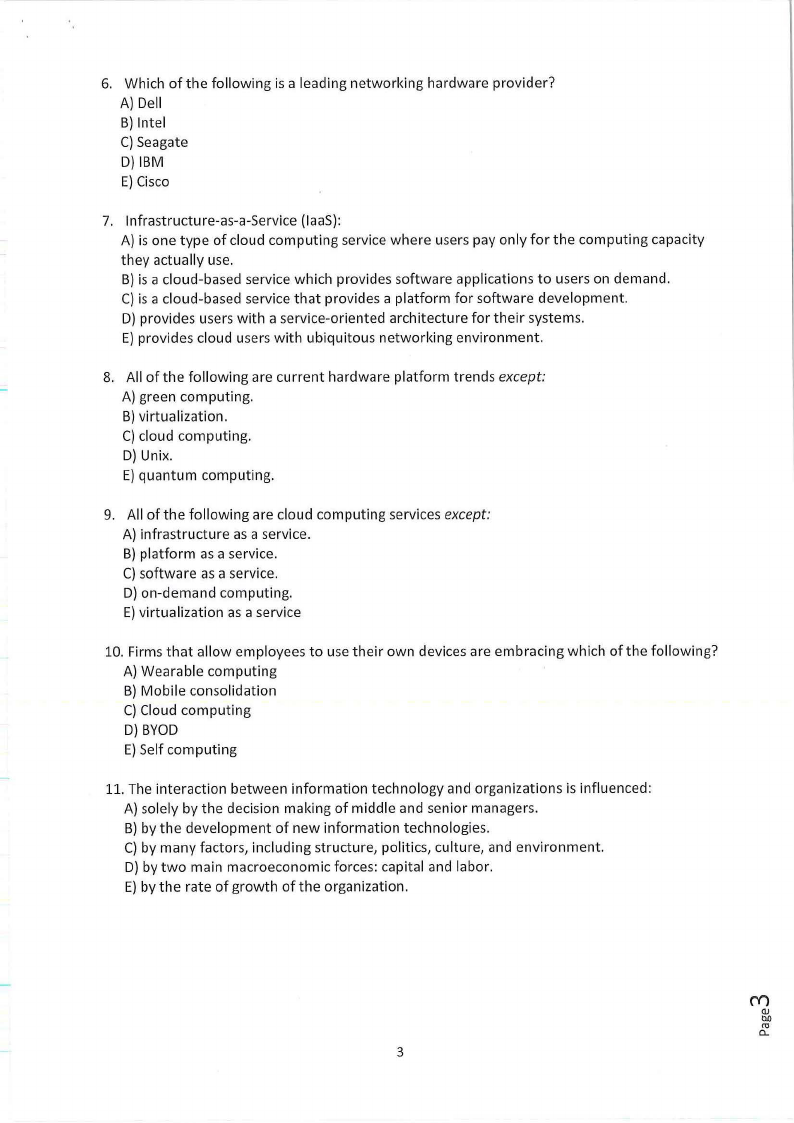
6. Which of the following is a leading networking hardware provider?
A) Dell
B) Intel
C) Seagate
D) IBM
E) Cisco
7. Infrastructure-as-a-Service (laaS):
A) is one type of cloud computing service where users pay only for the computing capacity
they actually use.
B) is a cloud-based service which provides software applications to users on demand.
C) is a cloud-based service that provides a platform for software development.
D) provides users with a service-oriented architecture for their systems.
E) provides cloud users with ubiquitous networking environment.
8. All of the following are current hardware platform trends except:
A) green computing.
B) virtualization.
C) cloud computing.
D) Unix.
E) quantum computing.
9. All of the following are cloud computing services except:
A) infrastructure as a service.
B) platform as a service.
C) software as a service.
D) on-demand computing.
E) virtualization as a service
10. Firms that allow employees to use their own devices are embracing which of the following?
A) Wearable computing
B) Mobile consolidation
C) Cloud computing
D) BYOD
E) Self computing
11. The interaction between information technology and organizations is influenced:
A) solely by the decision making of middle and senior managers.
B) by the development of new information technologies.
C) by many factors, including structure, politics, culture, and environment.
D) by two main macroeconomic forces: capital and labor.
E) by the rate of growth of the organization.
rn
<I)
llO
ro
0..
3
 |
4 Page 4 |
▲back to top |
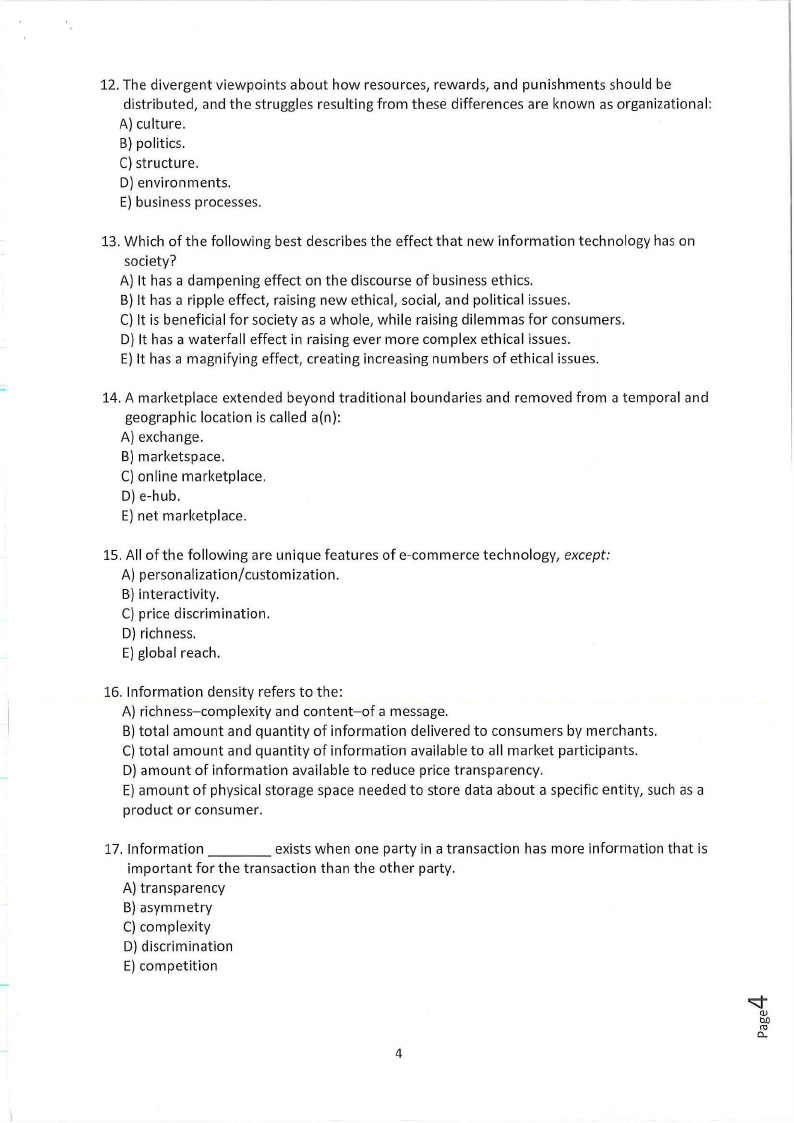
12. The divergent viewpoints about how resources, rewards, and punishments should be
distributed, and the struggles resulting from these differences are known as organizational:
A) culture.
B) politics.
C) structure.
D) environments.
E) business processes.
13. Which of the following best describes the effect that new information technology has on
society?
A) It has a dampening effect on the discourse of business ethics.
B) It has a ripple effect, raising new ethical, social, and political issues.
C) It is beneficial for society as a whole, while raising dilemmas for consumers.
D) It has a waterfall effect in raising ever more complex ethical issues.
E) It has a magnifying effect, creating increasing numbers of ethical issues.
14. A marketplace extended beyond traditional boundaries and removed from a temporal and
geographic location is called a(n):
A) exchange.
B) marketspace.
C) online marketplace.
D) e-hub.
E) net marketplace.
15. All of the following are unique features of e-commerce technology, except:
A) personalization/customization.
B) interactivity.
C) price discrimination.
D) richness.
E) global reach.
16. Information density refers to the:
A) richness-complexity and content-of a message.
B) total amount and quantity of information delivered to consumers by merchants.
C)total amount and quantity of information available to all market participants.
D) amount of information available to reduce price transparency.
E) amount of physical storage space needed to store data about a specific entity, such as a
product or consumer.
17. Information ____
exists when one party in a transaction has more information that is
important for the transaction than the other party.
A) transparency
B) asymmetry
C) complexity
D) discrimination
E) competition
o:::j"
(I)
abr.oO.
4
 |
5 Page 5 |
▲back to top |
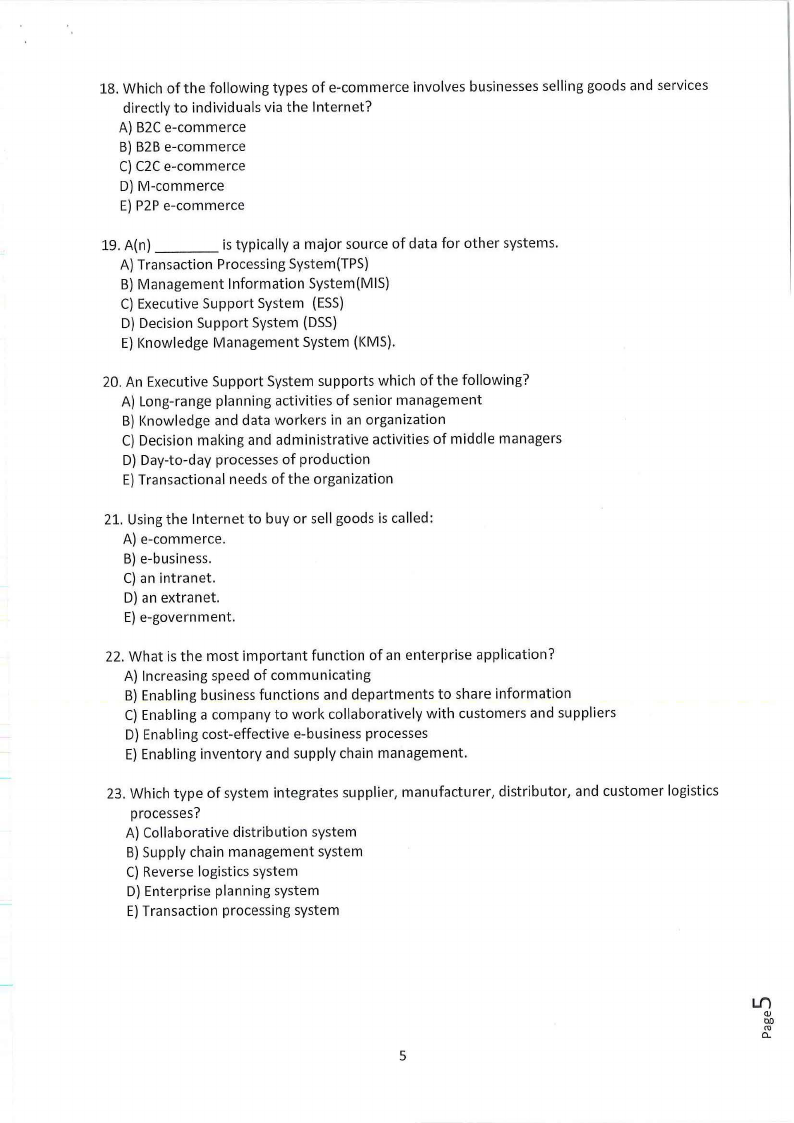
18. Which of the following types of e-commerce involves businesses selling goods and services
directly to individuals via the Internet?
A) B2C e-commerce
B) B2B e-commerce
C) C2Ce-commerce
D) M-commerce
E) P2Pe-commerce
19. A(n) ____
is typically a major source of data for other systems.
A) Transaction Processing System{TPS)
B) Management Information System(MIS)
C) Executive Support System (ESS)
D) Decision Support System (DSS)
E) Knowledge Management System (KMS).
20. An Executive Support System supports which of the following?
A) Long-range planning activities of senior management
B) Knowledge and data workers in an organization
C) Decision making and administrative activities of middle managers
D) Day-to-day processes of production
E) Transactional needs of the organization
21. Using the Internet to buy or sell goods is called:
A) e-commerce.
B) e-business.
C) an intranet.
D) an extranet.
E) e-government.
22. What is the most important function of an enterprise application?
A) Increasing speed of communicating
B) Enabling business functions and departments to share information
C) Enabling a company to work collaboratively with customers and suppliers
D) Enabling cost-effective e-business processes
E) Enabling inventory and supply chain management.
23. Which type of system integrates supplier, manufacturer,
processes?
A) Collaborative distribution system
B) Supply chain management system
C) Reverse logistics system
D) Enterprise planning system
E) Transaction processing system
distributor,
and customer logistics
Lf)
<lJ
0ro0
0..
5
 |
6 Page 6 |
▲back to top |
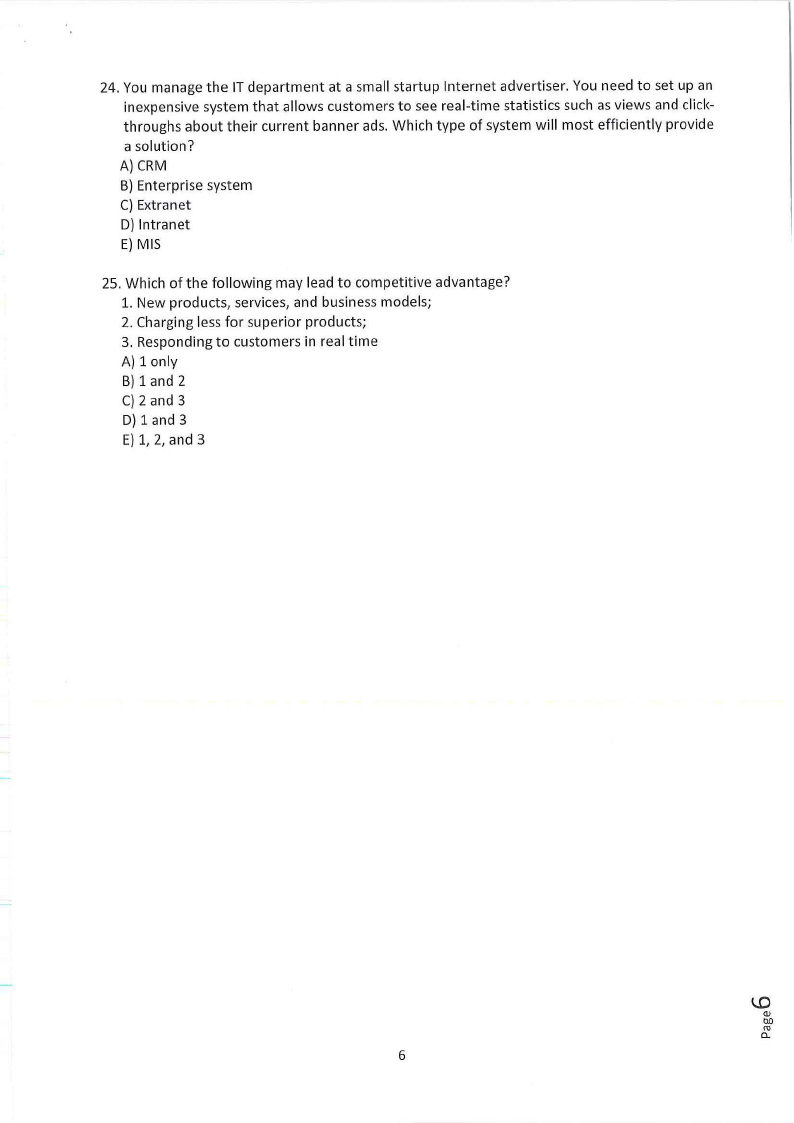
24. You manage the IT department at a small startup Internet advertiser. You need to set up an
inexpensive system that allows customers to see real-time statistics such as views and click-
throughs about their current banner ads. Which type of system will most efficiently provide
a solution?
A}CRM
B} Enterprise system
C}Extranet
D} Intranet
E) MIS
25. Which of the following may lead to competitive advantage?
1. New products, services, and business models;
2. Charging less for superior products;
3. Responding to customers in real time
A) 1 only
B}land2
C}2 and 3
D}land3
E}1, 2, and 3
Q)
M
ar.o.
6
 |
7 Page 7 |
▲back to top |
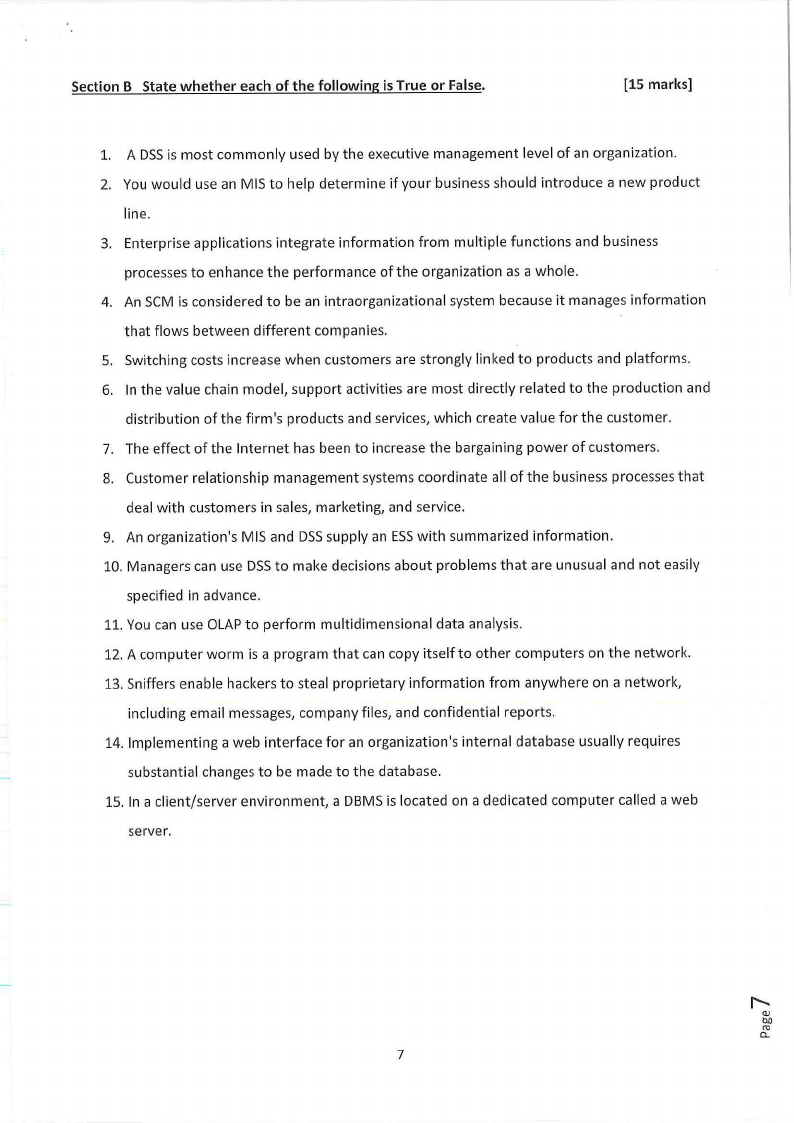
Section B State whether each of the following is True or False.
[15 marks]
1. A DSSis most commonly used by the executive management level of an organization.
2. You would use an MIS to help determine if your business should introduce a new product
line.
3. Enterprise applications integrate information from multiple functions and business
processes to enhance the performance of the organization as a whole.
4. An SCM is considered to be an intraorganizational system because it manages information
that flows between different companies.
5. Switching costs increase when customers are strongly linked to products and platforms.
6. In the value chain model, support activities are most directly related to the production and
distribution of the firm's products and services, which create value for the customer.
7. The effect of the Internet has been to increase the bargaining power of customers.
8. Customer relationship management systems coordinate all of the business processes that
deal with customers in sales, marketing, and service.
9. An organization's MIS and DSSsupply an ESSwith summarized information.
10. Managers can use DSSto make decisions about problems that are unusual and not easily
specified in advance.
11. You can use OLAPto perform multidimensional data analysis.
12. A computer worm is a program that can copy itself to other computers on the network.
13. Sniffers enable hackers to steal proprietary information from anywhere on a network,
including email messages, company files, and confidential reports.
14. Implementing a web interface for an organization's internal database usually requires
substantial changes to be made to the database.
15. In a client/server environment, a DBMS is located on a dedicated computer called a web
server.
"Q)
l:lO
ro
0..
7
 |
8 Page 8 |
▲back to top |
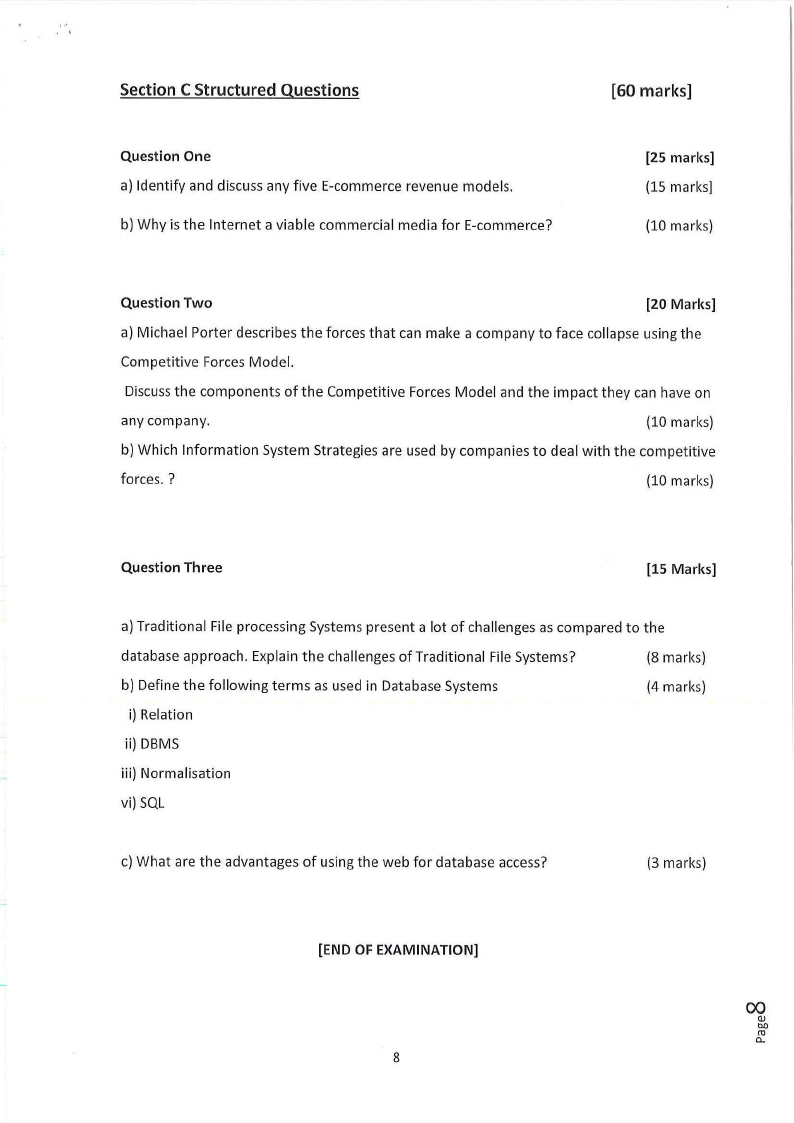
, .•
.'
Section C Structured Questions
Question One
a) Identify and discuss any five E-commerce revenue models.
b) Why is the Internet a viable commercial media for E-commerce?
[60 marks]
[25 marks]
(15 marks]
(10 marks)
Question Two
[20 Marks]
a) Michael Porter describes the forces that can make a company to face collapse using the
Competitive Forces Model.
Discussthe components of the Competitive Forces Model and the impact they can have on
any company.
(10 marks)
b) Which Information System Strategies are used by companies to deal with the competitive
forces. ?
(10 marks)
Question Three
[15 Marks]
a) Traditional File processing Systems present a lot of challenges as compared to the
database approach. Explain the challenges of Traditional File Systems?
(8 marks)
b) Define the following terms as used in Database Systems
(4 marks)
i) Relation
ii) DBMS
iii) Normalisation
vi) SQL
c) What are the advantages of using the web for database access?
(3 marks)
[END OF EXAMINATION]
00
Q)
0ro.0
CL
8





